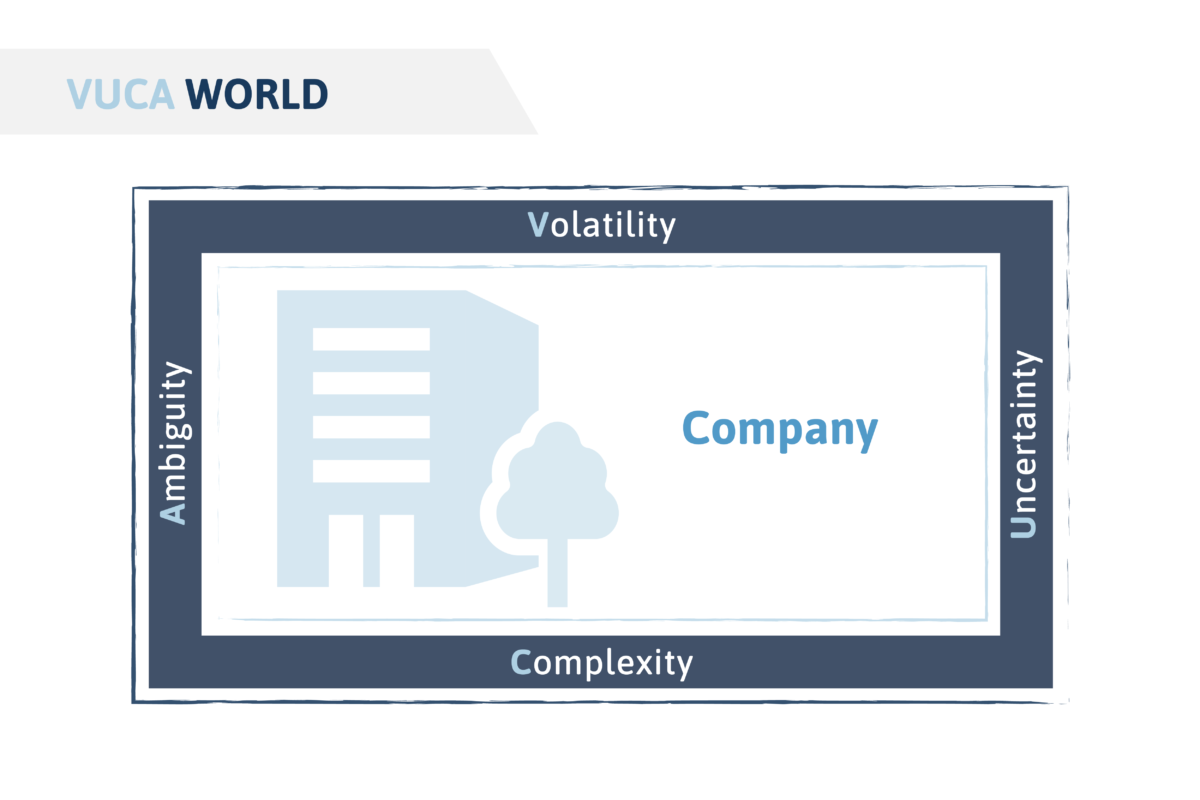VUCA – Successful business(es) in turbulent times
Companies today are faced with the challenge of asserting themselves in a world characterized by volatility, uncertainty, complexity and ambiguity. The world has become “VUCA” and understanding the impact and dealing with volatility, uncertainty, complexity and ambiguity (VUCA) is critical to a company’s success. This article provides key insights and strategies to successfully navigate through challenging environments.
Background and relevance of the VUCA model
The VUCA model originated in the 1990s in the US Army. After the end of the Cold War and the collapse of the Soviet Union, a phase of disorientation set in, as there was no clearly defined enemy and therefore no clear objective. In this new reality, it was crucial for the military leadership to react to unpredictable conditions. Innovative decision-making strategies were developed that were tailored to the specific challenges of an increasingly complex and dynamic world. The acronym VUCA – volatility, uncertainty, complexity and ambiguity – summarizes the characteristics of this new environment.
Nowadays, the VUCA concept has become a fundamental basis for companies that have to operate in an equally unpredictable market. Advancing digitalization, global networking and complex interdependencies have significantly changed the dynamics of markets. These developments intensify the challenges that companies face and require a rethink of strategies and decision-making processes. What was once designed to cope with military uncertainties now serves as a valuable tool for companies to develop sustainable strategies and navigate successfully in a volatile and complex business world.
The VUCA world
In order to understand the aspects of the VUCA model more clearly, the four central components – volatility, uncertainty, complexity and ambiguity – are now considered in detail. This analysis helps to further clarify the relevance of the individual elements for companies in today’s dynamic business world.
Volatility
Volatility describes the rapid and unpredictable changes that occur in markets and industries in today’s economy. A striking example of this is the 2008 financial crisis, which led to drastic market changes in a very short space of time. We are currently experiencing similar turbulence due to the rapid development and introduction of new technologies such as artificial intelligence.
To remain competitive, companies must not only be able to recognize such changes quickly, but also develop agile strategies to respond flexibly. This requires a proactive corporate culture that encourages innovation and quick decision-making. The ability to respond appropriately to volatile conditions is crucial for long-term success
Uncertainty
Events such as the COVID-19 pandemic or BREXIT have shown how difficult it is to predict changes. Such unexpected developments require companies to be highly responsive and flexible.
To remain successful in such times, companies must embed strategic flexibility and resilience firmly into their planning. An agile transformation that relies on fast, adaptive action and counters uncertainty with small, low-risk experiments is crucial here. Only by acting quickly and being able to adapt quickly to new conditions can companies remain capable of acting even in unforeseeable crises.
Complexity
Globalization, diversification, specialization and the complex mega-trends of the modern economy have created an almost unmanageable network of interconnected factors that have an unpredictably strong influence on developments. One example of this is supply chains, which used to be manageable but now encompass a multitude of countries, cultures and corporate philosophies.
In order to be able to deal with this unmanageable complexity, it is of central importance to convey clarity about what is to be achieved, what assumptions are to be made and how these assumptions can be tested with as little effort and risk as possible. The ability to test hypotheses with experiments determines whether a company can be successful in an unmanageably complex environment.
Ambiguity
In most cases, it is not possible to derive a clearly “correct” interpretation from the available information. Trends can be read differently, regulations can be interpreted differently and even individual words can be understood differently.
This makes it even more important for a company to formulate hypotheses and test them with short feedback loops. The faster a company manages to test its assumptions in the real market, the more successfully it can find a way through ambiguous situations and avoid falling into rigidity if there is no clear path.
Agile frameworks do not solve all problems but provide a good basis for discussion on internal structures and viable first steps to deal with these framework conditions.
Example: COVID-19 pandemic
The COVID-19 pandemic was a striking example of how all components of the VUCA world became more pronounced in a very short space of time.
- Volatility was evident in the rapidly changing epidemiological conditions and the associated regulations.
- Uncertainty prevailed, as both epidemiological developments and political decisions were almost impossible to predict.
- Complexity arose from the different measures and findings, which varied greatly from country to country and region to region and were often not transferable.
- Ambiguity arose from contradictory statements by scientists and decision-makers, who often assessed the situation differently.
The pandemic revealed that many companies were not sufficiently resilient to adapt to these challenges. Rigid supply chains collapsed under the pressure and led to massive supply bottlenecks. The COVID-19 crisis highlighted the need to invest in more agile structures and flexible processes in order to better respond to future uncertainties.
Mastering the VUCA world: strategies for success
There are ways in which companies can successfully overcome the challenges of the VUCA world. The concept of Vision, Understanding, Clarity and Agility (VUCA-Prime) offers valuable approaches to effectively counter the factors of volatility, uncertainty, complexity and ambiguity.
Vision rises above volatility.
A clear, long-term vision gives the company direction, even if the general conditions change. It enables employees to align themselves with common goals and maintain focus in uncertain times. A strong vision thus acts as a stable anchor that provides direction and encourages commitment, regardless of the challenges that volatility brings.
An illustrative example of this is the comparison between a “classic company”, which can be imagined as a sluggish ocean liner, and an agile company, which consists of a fleet of maneuverable small ships. The agility of this fleet makes it possible to evade sudden obstacles quickly. But each ship needs a compass and an agreed direction so that the entire fleet can find its way back together and successfully pursue its common goals.
Understanding reduces uncertainty.
Continuously analyzing the relationships between economic, political and regulatory factors creates a better basis for well-founded forecasts. By continuously analyzing the market and observing the competition, companies can identify current trends and potential risks at an early stage. This deeper understanding makes it possible to make informed decisions and react proactively to changes, significantly reducing uncertainty.
Clarity counters complexity.
In many cases, complexity and a lack of information are the result of a lack of transparency. When decisions and processes are communicated transparently and comprehensibly, and employees have access to relevant information, they create the basis for informed and promising decisions. This clarity not only promotes trust within the company, but also facilitates collaboration and adaptability in a complex environment. Through targeted communication and openness, companies can reduce complexity and act more effectively.
Agility defeats ambiguity.
In an uncertain future with numerous possible scenarios, agility enables companies to remain flexible and react quickly to situations that arise. With an agile mindset and this agile approach, companies can better navigate uncertainty and continuously adapt their strategies.
VUCA world and business agility: how are they connected?
Business agility describes the ability of a company to constantly adapt its strategy to changing, unclear framework conditions. Business agility is not a specific method or framework, but the ability to be successful in a VUCA world with constantly changing framework conditions, opportunities and threats.
Quick wins and far-reaching changes are often necessary in the following areas:
- Adaptation of the organizational structure: Flexible corporate structures are crucial to be able to react quickly to changes. Flat hierarchies and decentralized decision-making enable a rapid exchange of information and accelerate the decision-making process. Agile frameworks and approaches such as Flight Levels offer promising approaches here.
- Effective change management: As the environment and market conditions in which a company operates change frequently and continuously, it is essential to adapt to rapid and permanent changes throughout the company. Managing these changes sustainably and effectively is crucial to success. Successful change management is characterized by the involvement of the entire workforce. This requires regular, open communication and training in order to actively involve employees in the change process.
- Promoting a resilient corporate culture: Openness, trust and continuous learning are the foundations of a resilient and agile corporate culture. Companies can specifically promote and cultivate these values through various measures in order to create a positive and adaptable working environment.
Conclusion
Today’s world is more turbulent than ever. However, companies can use these challenges to their advantage. By developing strategies that help them navigate the VUCA world more effectively, they can set themselves apart from the competition. With a clear focus on agility, transparency and continuous learning, companies can not only react to change, but also proactively seize opportunities and achieve sustainable success.
EFS Consulting offers customized solutions to successfully master the challenges of the VUCA world. Contact us to develop a suitable strategy for the future together.




